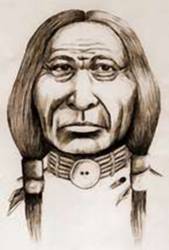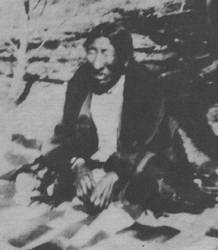One of the more interesting aspects of the relationships between the first Euro-settlers, and the Aboriginal People who lived here, is the difference a border could make.

In pre- Euro-Settlement days, the border was theoretical at best, and ignored in practice. American fur traders journeyed north and west out of St. Louis, while the British Hudson’s Bay Co., based on Hudson Bay, then Red River, mostly kept to the north and west. The Montreal-based Northwest Co. competed freely with both, with a strong presence on Lake Superior and along the prairie rivers. Aboriginal hunters followed the buffalo and the seasons, traded with whoever was available or whoever offered the best deal.
That worked for a long time, until the advent of European settlement and the conflict that was destined to ensue. South of the border that conflict escalated into warfare and Canada often became a haven for Aboriginals People fleeing from the U.S. Army.
Somehow tribes and individuals, who, south of the border had the reputation of being fierce warriors, were on this side of the border, peaceful citizens.
If ever a native warrior came to our region with a bad reputation, though, that would be the Inkpaduta. He was a Chief of the Wahpekuta, a band of Santee Dakota.
To white settlers south of our border he was viewed as a savage, leader of the bloody Spirit Lake Massacre in Iowa in 1857, and a participant in the Dakota War in Minnesota in 1862. He became known as the “scourge of the Plains”. For a time the popular press blamed him for every altercation involving the Dakota. Even some of his own people turned away from him for fear of white retributions on their villages when he was in the vicinity. His image as an elusive outlaw was bolstered by the fact he was never captured and never surrendered.
Recently, however, historical reinterpretation places more emphasis on his uncompromising resistance to the white takeover of Indian lands. And more stress is placed on his long record of peaceful co-existence with white settlers until provocations and hardships caused him to rebel.
It is true that in 1857 he lead about a dozen or so warriors in attacks on settlers in the aforementioned Spirit Lake Massacre, actually a series of attacks, in which about 40 deaths were recorded and four women were taken hostage. It is likely also true that these raids were in retaliation for the murders of members of his family and the ongoing encroachment of white settlers on Sioux hunting grounds.
Inkpaduta was in Minnesota during the Dakota Wars, and although he didn’t play a large role in that conflict, he was pursued aggressively by General Scully in the aftermath. After suffering two losses in battle he crossed into Canada where he spent time on Turtle Mountain before heading to the Montana Territory where he participated in the ongoing struggle between the Dakota and the U.S. Army.

He is credited by some with being an ally of Sitting Bull and Crazy Horse, and with being part of the large coalition of forces that dealt General Custer a devastating defeat in 1876. These reports are likely exaggerated, as he was by that time an old man and quite blind. His sons and followers, however, did participate in that battle. Inkpaduta returned with some followers soon afterwards to the safety of the north side of Turtle Mountain. A newspaper report has him crossing into Canada with Sitting Bull. He and members of his family lived out the rest of their life in Canada.
We may never be sure which way to see Inkpaduta, but we can be fairly certain that while in Canada, he lived a peaceful life.
Both the Morton and Turtle Mountain local histories note his presence in the region. Other reports have him as part of a group of Wahpekuta Sioux who settled on the Canupawakpa Reserve near Pipestone. Most sources say he died in 1879 or 1881. U.S. sources cite, “the Brandon area” as his place of death. In 1934, two of his sons, Little Spirit (Wanagi Ciquana) and Charley Maku, and also a daughter, were living in the Pipestone region.
All reports from the north side of the border agree that there was no trouble, from Inkpaduta or his followers.
. . . . .
Author: Ken Storie
Sources:
Deloraine History Book Committee. Deloraine Scans a Century 1880 - 1980: Altona. Friesen Printers, 1980 Committee of the J.A. Victor Museum and New Horizons. Reflections - Turtle Mountain Municipality and Killarney, 1882- 1982. Inter-collegiate Press of Canada, 1982 Larson, Peggy Rodina. A New Look at the Elusive Inkpaduata. Minnesota History Magazine, Spring 1982 Manitoba Free Press. The Sioux Indians. 21 July, 1877. pp6 http://indianbattles.weebly.com http://www.american-tribes.com/Dakota/bio/Inkpaduta.htm
Photos: http://www.farwest.it/?p=72 http://www.american-tribes.com/Dakota/bio/Inkpaduta.htm
https://www.pinterest.com/pin/235524255487290942/ Wikipedia
